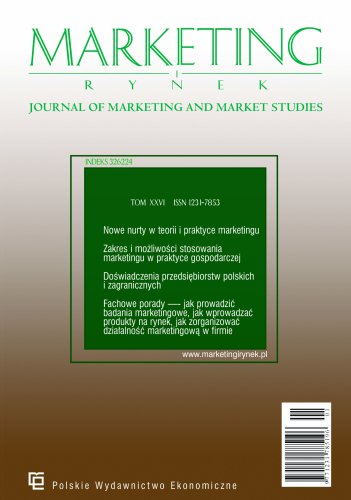Motives of second-hand products purchase — the qualitative study results
Second-hand buying helps to decrease the level of production and for that reason it may be recognized as a sustainable behaviour of a consumer. The main goal of the paper is to define and recognise motivations, opinions and beliefs about the purchase of second-hand products sold in various retail trade formats and to examine whether customers are motivated by their care for the environment, the desire to escape from the consumption system or attempt to follow the principles of sustainable consumption. The research was carried out using FGI — Focus Group Interview with seven people aged 20–30, including five women and two men. The criterion for the respondent selection was whether they bought a used product in the last 12 months. The survey was conducted on 15th April 2019. Answers and their analysis have shown that sustainable consumption is not the main motivation of respondents to buy used products. The most common reason is the low price of the products. However, some responses were indirectly related to sustainable consumption.
References
References
Abimola, O. (2012). The international trade in second hand clothing: Managing information asymmetry between West African and British traders. Textile, 102, 184–199. https://doi.org/10.2752/175183512x13315695424310
Baden, S. & Barber, C. (2005). The impact of the second-hand clothing trade on developing countries. GB: Oxfam. https://doi.org/10.21201/2005.112464
Barahona, V. L. & Sanchez, J. N. (2012). Dressing the poor: The provision of clothing among the lower classes in eighteen century Madrid. Textile History, 431, 23–42. https://doi.org/10.1179/174329512x13284471321127
Benson, S. P. (2007). What goes round comes round: Second hand clothing, furniture, and tools in working class lives in the interwar United States. Journal of Women's History, 91, 17–31. https://doi.org/10.1353/jowh.2007.0005
Besnier, N. (2004). Consumption and cosmopolitanism: Practicing, modernity at the second hand marketplace in Nuku'alofa, Tonga. Anthropological Quarterly, 771, 7–45. https://doi.org/10.1353/anq.2004.0002
Brookshire, J. E. H. & Hodges, N. N. (2009). Socially responsible consumer behavior? Exploring used clothing donation behavior. Clothing & Textiles Research Journal, 273, 179–196. https://doi.org/10.1177/0887302x08327199
Cervellon, M. C., Carey, L. & Harms, T. (2012). Something old, something used: Determinants of women's purchase of vintage fashion vs second-hand fashion. International Journal of Retail and Distribution Management, 40(12), 956–974. https://doi.org/10.1108/09590551211274946
Gregson, N. & Crewe L. (2003). Second-Hand Cultures. New York: Berg.
Guiot, D. & Roux, D. (2008). Measuring second hand shopping motives, antecedents and consequences. Recherche et Applications en Marketing, 234, 63–94. https://doi.org/10.1177/205157070802300404
Guiot, D. & Roux, D. (2010). A Second hand shoppers' motivation scale: Antecedents, consequences, and implications for retailers. Journal of Retailing, 864, 355–371. https://doi.org/10.1016/j.jretai.2010.08.002
Herjanto, H., Scheller-Sampson, J. & Erickson, E. (2016). The increasing phenomenon of second-hand clothes purchase: Insights from the literature. Journal Manajemen dan Kewirausahaan, 18(1), 1–15. https://doi.org/10.9744/jmk.18.1.1-15
Hiller-Connell, K. Y. (2011). Exploring consumers' perceptions of eco-conscious apparel acquisition behaviors. Social Responsibility Journal, 7(1), 61–73. https://doi.org/10.1108/17471111111114549
Mintel. (2009). Ethical Clothing — UK. Mintel International Group.
Nakano, Y. (2007). Perceptions towards clothes with recycled content and environmental awareness: The development of end markets. Cambridge: Woodhead Publishing Series in Textiles. https://doi.org/10.1533/9781845693039.1.3
Norum, P. & Marjorie, N. (2017). Factors affecting consumer acquisition of secondhand clothing in the USA. Journal of Fashion Marketing and Management, 21(2), 206–218. https://doi.org/10.1108/JFMM-10-2016-0090.
Oronowicz-Kida, E. (2012). Nazwy sklepów z odzieżą używaną w aspekcie pragmatycznym na przykładzie południowo-wschodniej Polski. Downloaded from https://www.pulib.sk/web/kniznica/elpub/dokument/olostiak3/subor/38-oronowicz-kida.pdf
Oxford Dictionaries (2019). Downloaded from https://en.oxforddictionaries.com/definition/second-hand
Palmer, A. (2005). Vintage Whores and Vintage Virgins: Second-Hand Fashion in the Twenty-First Century. In A. Palmer & H. Clark (eds), Old Clothes, New Looks: Second Hand Fashion (197–213). New York: Berg. https://doi.org/10.2752/9781847888815/ocnl0022
Peattie, K. & Peattie S. (2009). Social Marketing: A Pathway to Consumption Reduction? Journal of Business Research, 62(February). https://doi.org/10.1016/j.jbusres.2008.01.033
Petrescu, M. & Bhatli, D. (2013). Consumer behaviour in flea markets and marketing to the bottom of the pyramid. Journal of Management Research, 13(1), 55–63.
Razzouk, N. Y. & Gourley, D. (1982). Swap meets: a profile of shoppers. Arizona Business, 29, 8–12.
Roux, D. & Korchia, M. (2006). Am I what I wear? An exploratory study of symbolic meanings associated with secondhand clothing. NA — Advances in Consumer Research, 33, 29–35. Association for Consumer Research.
Ruoh-Nan, Y., Su, Y. & Huimin, X. (2015). Second-hand clothing shopping among college students: The role of psychographic characteristics. Young Consumers, 16(1), 85–98. https://doi.org/10.1108/yc-02-2014-00429
Rybowska, A. (2017). Zachowania konsumentów na rynku second hand. Marketing i Zarządzanie. Problemy Zarządzania, Finansów i Marketingu, (2/48), 95–104. https://doi.org/10.18276/miz.2017.48-09
Sherman, E., McCrohan, K. & Smith, J. D. (1985). Informal retailing: An analysis of products, attitudes, and expectations. Advances in Consumer Research, 12(1), 204–208.
Sherry, J. F. (1990). A sociocultural analysis of a mid-western American flea market. Journal of Consumer Research, 17(1), 13–30.
Stone, J., Horne, S. & Hibbert, S.A. (1996). Car boot sales: A study of hopping motives in an alternative retail format. International Journal of Retail & Distribution Management, 24(11), 4–15. https://doi.org/10.1108/09590559610131682
Turunen, L. L. M. & Leipämaa-Leskinen, H. (2015). Pre-loved luxury: identifying the meanings of second-hand luxury possessions. Journal of Product & Brand Management, 241, 57–65. https://doi.org/10.1108/jpbm-05-2014-0603
Williams, C. C. & Paddock, C. (2003). The meanings of informal and second hand retail channels: some evidence from Leicester. International Review of Retail, Distribution and Consumer Research, 13(3), 317–336. https://doi.org/10.1080/0959396032000101372
Williams, C. C. & Windebank, J. (2000). Beyond formal retailing and consumer services: an examination of how households acquire goods and services. Journal of Retailing and Consumer Services, 7(3), 129–136. https://doi.org/10.1016/s0969-6989(99)00016-8
Xu, Y., Chen, Y., Burman, R. & Zhao, H. (2014). Second hand clothing consumption: A cross cultural comparison between American and Chinese young consumers. International Journal of Consumer Studies, 38, 670–677. https://doi.org/10.1111/ijcs.12139
Yan, R.-N., Bae, S. Y. & Xu, H. (2015). Second-hand clothing shopping among college students: the role of psychographic character. Young Consumers, 16(1), 85–98. https://doi.org/10.1108/yc-02-2014-00429
Yavas, U. & Riecken, G. (1981). Heavy, medium, light shoppers and nonshoppers of a used merchandise outlet. Journal of Business Research, 9(1), 243–253. https://doi.org/10.1016/0148-2963(81)90019-9
Zavestoski, S. (2002). The Social-Psychological Bases of Anticonsumption Attitudes. Psychology & Marketing, 192, 149–165. https://doi.org/10.1002/mar.10007

